A Bit About the Travellers and Their Horses...
|
As a breeder of Gypsy Vanner Horses we feel that it is important to understand and appreciate the history of the people that created this amazing breed. The Gypsy folk are a private people and don't often welcome outside intrusion, nor do they keep written records. Therefore much of their history and customs remain a mystery. The following information has been gathered from a variety of sources, and serves as a brief introduction. Click on one of the topics below to go to the area that interests you.
|
|
|
|
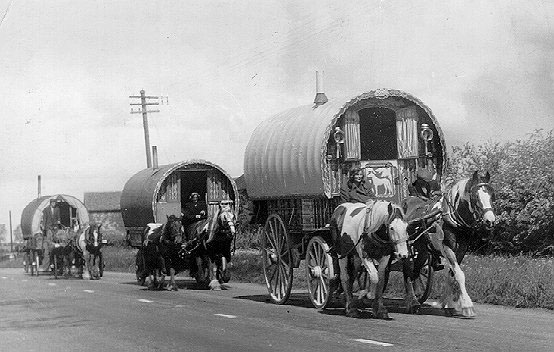
Gypsy Caravan
Date Unknown
|
The People...
|
The following is a brief summary of the information that I have found or heard regarding the people known as Gypsies or Travellers from which we get our horses:
Originally the Gypsy folk didn't call themselves Gypsies, they had names that reflected their area of origin. Encarta tells us that the Roma are divided into groups sometimes referred to as nations or tribes. These divisions generally reflect historical patterns of settlement in different geographic areas. The European tribes include the Calé of Spain, Finland, and Wales; the Sinti of Germany and central Europe; the Manouche of France; the Romanichals of the United Kingdom; the Boyash of Romania; and the Roma, a subgroup of the larger Roma population, of Eastern Europe and the Balkans. Although historically renowned as wanderers, the vast majority of modern Roma live in settled communities. Today they are often referred to as Gypsies, Travellers, or Romany folk, or the more derogatory Tinker.
Sadly, history has seen the Gypsies persecuted for many reasons. Their roaming lifestyle caused them to always be the outsiders, belonging to no country. They were often viewed as vagabonds roaming the countryside looking to make a quick buck. Additionally their close knit, secretive behavior often caused fear and misunderstanding in those not of the Gypsies. Generations of Gypsies have endured persecution by the gaje (not of the Rom/Gypsies) as a result of their aura of strangeness.
Political leaders have historically branded Gypsies as undesirables, making them scapegoats for local problems. In the past it was common place for anyone who gave them refuge to be punished, anyone who killed a Gypsy could keep his property, any local authority who did not arrest the Gypsies in his area would have to pay for any damage they did.
Today while many families have settled in communities, many gypsies still live the traditional life of a traveller living in their bow-topped wagons and moving from place to place. Local people still regard Gypsies with curiosity and suspicion. Understandably, the Gypsies are very reluctant about sharing their secrets and rarely allow non-gypsies access to their families. They maintain a very private life rich with culture and tradition. They often do not read or write, and therefore much of their culture is a mystery to those of us who are outsiders. It is possible to get a small glimpse of their lifestyle at a large gathering such as the Appleby Fair. Back to Top |
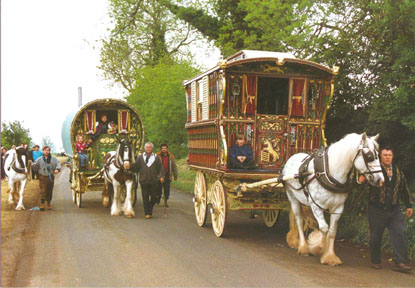
The Finney Family On The Way to Appleby Fair
Photo courtesy of Barrie Law
|
|
Origins of the Breed ...
|
The brightly-colored heavily-feathered horse gets it's name due to the simple fact that it is a horse bred and owned by the gypsies. It is called Gypsy Horse, Gypsy Cob, Gypsy Vanner, Irish Cob, Coloured Cob, Tinker Horse, and Romany Horse to name a few.
There is much speculation as to the origins of the "Gypsy Horse" and there are varying opinions as to what breeds were used to create the horse of today. Most agree that the ancestors of the Gypsy Horse were cold-blooded. Often you will hear that Shire and Clydesdale provided the bone and feather and Dales Pony or Fells Pony provided the smaller stature. Some suggest that there is Trotting Horse influence as well, improving upon the endurance of the draft breeds. It has also been said that the Friesian breed and a pacing breed known as the Gallower may well be involved in the make-up of the Gypsy Horse.
What is known is that the Travellers have developed and maintained this breed of horses over hundreds of years. Through selective breeding they have created a breed of horse that is not duplicated anywhere else in the world. Theirs is a small, hardy draft horse with flamboyant color and feather, and a calm and intelligent personality. Thanks to their rich tradition of oral history the owners of these horses can often trace their pedigree back through the years.Back to Top
|
Possible Background Breeds Of The Gypsy Horse... |
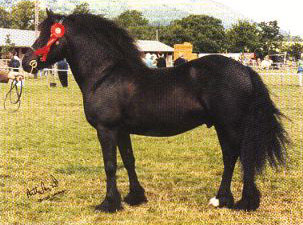
Dales Pony
Photo courtesy of Dales Pony Society
|
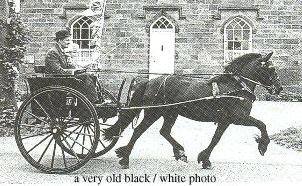
Old Photo of Dales Pony in Harness
Photo courtesy of Dales Pony Society |

Fell Pony Stallion
Lunesdale Mountain Mist
Photo courtesy of Fell Pony Society
|

Fell Pony Mare and Foal
Photo courtesy of Fell Pony Society |

Shire Stallion |

Clydesdale Stallion
|
Development of the Breed...
|
The following information from the folks at Harlequin Farms does a nice job of explaining the early development of the breed:
"Early Gypsies soon discovered what was necessary in the horses they owned and used. They had to be strong enough to pull their caravans and caravans weighed an enormous amount. Just imagine the weight, not only of the caravan itself, but the fact that it carried everything the entire family owned. All clothing, pots and pans, dishes, linens and most even had pot belly and/or cooking stoves. Most caravans weighed so much, that everyone except the very young and elderly, walked beside them as they journeyed from one place to another. Often, just the women actually "drove" and the men walked alongside to their next possible source of income or campsite for the night. So to be able to pull all this, their horses had to have solid, weighty bodies, huge bone, thick necks and a great layback of shoulder. They had to have strong legs and large feet. They had to be unflappable in any situation and absolutely solid and reliable in their interaction with humans, including children. They had to be tough enough to exist in the harshest of weather and often on meager food sources. They had to be able to pull a caravan all day if necessary covering sometimes 40 miles or more on hard roads or muddy lanes. They had to have a willing "work ethic" and always do what was required of them. In the past, most existed on what was found growing along country roads when the family camped for the night so they had to be what we refer to today, as "easy keepers". Back to Top
|
The following piece is from the Gypsycob.co.uk site explaining the effects of WW War I on the development of Gypsy Horses:
"During the First World War a lot of the horses in the Uk were bought by the Army and taken overseas, all sizes and shape of horse were utilized to pull canons, carry regiments into battle and carry injured from the fronts. The only type of horse the Army did not want to buy was the COLOURED horse, obviously these would not be very good in camouflage ! The Romany Gypsy, ever resourceful, had available an abundance of cheap, colorful, easily recognizable horses. They had been using horses to travel across Europe for centuries and some settled to traveling in England and Ireland. In England we have our own native breeds, which used to roam freely across certain parts of the country, such and the Fells and Dales of North England."
"Romany Gypsy's favored the flashiness and availability of the colored horse, the feather, hair and steady, hardworking nature of the heavy breeds, and needed the sturdy, compact, sure footed bodies of the Fell and Dales ponies. They continued breeding their horses using this mix of breeds, adapting their preferred size and build to suit their particular needs and likes. This continued and flourished as the Gypsies strived to have the best horse they could, that did the best job it could to fit in with their way of life. The Gypsy also liked the fact that the colored horse is easily recognized and could not be 'swapped' as easily as some solid colored horses!"
"One thing they will not tolerate was a bad tempered horse. All animals in a Gypsy family have to be totally safe with all the family."
"This selective breeding eventually diversified the Gypsy Cob into four categories. Up to 14.2hh, short, stocky, compact ponies used for pulling working flat carts. Up to 15hh big, powerful cobs used for pulling the living wagons and heavier loads. Over 15hh cobs with more Shire/Clydesdale blood, used for heavy loads and agricultural work. The Trotter, cobs usually crossed with Standardbred horses, used for road racing in Sulkie traps."
"The Romany people were, and still are dedicated, knowledgeable and skilful in breeding their own type of horse, even though they came up against severe discrimination against there way of life, their horses were almost expelled from the equine world."
"But, now the Romany has within its own tight knit community one of the most popular and sought after horses in the world, and they are rightly, quietly pleased with themselves."
For more related information please visit our friends at: http://www.gypsycobs.fsnet.co.uk
|
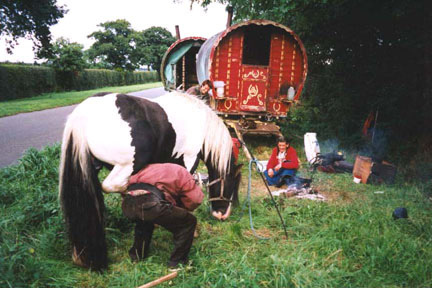
Hoof Care In Camp
Photo Compliments of Barrie Law
|
|
| The University of Liverpool also has a wonderful collection of photos and information. |
|
|